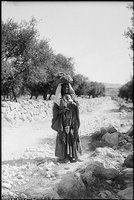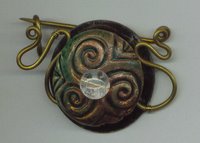 As a student in art history, I developed an interest in artifacts from Neolithic and bronze age civilizations. That interest is a large part of the reason that I started making ceramic beads and small vessels. Most of what we know about these ancient civilizations is based on the items (most showing exquisite workmanship considering the primitive tools available to them) found amongst burial sites. Some of the most common artifacts are spindle whorls. The spindles themselves, the shafts attached to the whorl around which the fibers were wrapped, were generally made of wood and have long since disappeared. The whorls, however, were often made of clay, stone, bone, or other materials. Many were carved with elaborate decoration. A favorite spindle was a treasured possession.
As a student in art history, I developed an interest in artifacts from Neolithic and bronze age civilizations. That interest is a large part of the reason that I started making ceramic beads and small vessels. Most of what we know about these ancient civilizations is based on the items (most showing exquisite workmanship considering the primitive tools available to them) found amongst burial sites. Some of the most common artifacts are spindle whorls. The spindles themselves, the shafts attached to the whorl around which the fibers were wrapped, were generally made of wood and have long since disappeared. The whorls, however, were often made of clay, stone, bone, or other materials. Many were carved with elaborate decoration. A favorite spindle was a treasured possession.I'm not sure when I realized what these spindle whorls signified. If recorded history is any indication, spinning was generally women's work. Every thread in every garment was spun in more or less the same way and passed through the fingers of a woman before being wound onto a spindle. Textiles were precious and were, almost exclusively, the domain of women. As such, spindle whorls were vitally important.
 Soon after I came to these realizations, I decided that I wanted to learn to spin. I began making beads intended to serve as spindle whorls and even tried (unsuccessfully) to teach myself to spin. On some level, I guess that I believed that learning to spin would connect me with all of those women throughout history who spun during otherwise idle moments to produce the threads that clothed their families.
Soon after I came to these realizations, I decided that I wanted to learn to spin. I began making beads intended to serve as spindle whorls and even tried (unsuccessfully) to teach myself to spin. On some level, I guess that I believed that learning to spin would connect me with all of those women throughout history who spun during otherwise idle moments to produce the threads that clothed their families.My own work in textiles has been sporadic at best. I constructed a backstrap loom and learned to weave as part of an art education class that I took in college. I learned to crochet when I was young and have picked up the hook and put it back down many times over the course of my life. I learned to knit in a DoDDS elementary school in 1976 long enough to knit a small acrylic flag for a school project. (The stars on the flag were not knit. They were actually made with gummed foil stars that were glued to the blue field with the foil side facing down.) I promptly forgot whatever knitting I'd learned and didn't try again until about two months ago.
 About a week after purchasing my first set of knitting needles and taking a knitting class taught by a friend of mine, I asked the owner of my favorite fiber store if she would be willing to teach me the fine art of spinning on a drop spindle. I'm pretty sure that my life will never be the same. I've been spinning for almost two months now. I have a beautiful spinning wheel which offered me the opportunity to learn about the parts, mechanics, and intricate workings of the wheel before I'd even had a chance to spin my first yarn. (A design flaw in the original footman resulted in a break, either while I was transporting it or at some point before it came home with me... The footman had previously broken in the same place and had been repaired. It was now time to replace it which became an unexpected opportunity to re-design the footman.)
About a week after purchasing my first set of knitting needles and taking a knitting class taught by a friend of mine, I asked the owner of my favorite fiber store if she would be willing to teach me the fine art of spinning on a drop spindle. I'm pretty sure that my life will never be the same. I've been spinning for almost two months now. I have a beautiful spinning wheel which offered me the opportunity to learn about the parts, mechanics, and intricate workings of the wheel before I'd even had a chance to spin my first yarn. (A design flaw in the original footman resulted in a break, either while I was transporting it or at some point before it came home with me... The footman had previously broken in the same place and had been repaired. It was now time to replace it which became an unexpected opportunity to re-design the footman.)Between spinning and knitting, my interest in fiber and the textile arts has gone from a mild curiosity and occasional hobby to an overwhelming obsession. Since those interests were what motivated me to start making the shawl pins again (combined with the self-doubt that grew from an interpersonal conflict that I've already wasted too much time re-hashing here) it seemed only natural for me to renew my acquaintance with spindle whorl motifs and begin to produce focal beads based on them.
 I've already uploaded a couple of my new spindle whorl shawl pins to my Etsy Shop. I'll be uploading more as time permits. (Life with toddler has a way of impressing upon you the things that you **MUST** do vs. the things that you'd like to do.) The process of making them is actually a bit of a departure for me. After carving the spindle whorl beads, I made press molds of them. I've made press molds in the past with varying degrees of success but don't always enjoy using them because I like the intimate connection with each piece that I make. Since one of my goals for my shawl pins has been to keep them as affordable as possible, I wanted to press mold the spindle whorls to reduce the labor and keep the cost down. I used a simplified variation of the technique used by Melanie at Earthenwood Studio. Once the individual beads have been press molded, I refine the carving a bit to clean up the lines and ensure that they don't have a "stamped out" appearance. The result is that each of the beads has its own character and individual feel to it from being hand-worked but I'm not investing several hours in each of them. It feels like a good compromise.
I've already uploaded a couple of my new spindle whorl shawl pins to my Etsy Shop. I'll be uploading more as time permits. (Life with toddler has a way of impressing upon you the things that you **MUST** do vs. the things that you'd like to do.) The process of making them is actually a bit of a departure for me. After carving the spindle whorl beads, I made press molds of them. I've made press molds in the past with varying degrees of success but don't always enjoy using them because I like the intimate connection with each piece that I make. Since one of my goals for my shawl pins has been to keep them as affordable as possible, I wanted to press mold the spindle whorls to reduce the labor and keep the cost down. I used a simplified variation of the technique used by Melanie at Earthenwood Studio. Once the individual beads have been press molded, I refine the carving a bit to clean up the lines and ensure that they don't have a "stamped out" appearance. The result is that each of the beads has its own character and individual feel to it from being hand-worked but I'm not investing several hours in each of them. It feels like a good compromise.IMAGE SOURCE: Woman, possibly Bedouin, holding spindle, standing in road [Stereo glass plate taken between 1898 and 1946]Taken either by the American Colony Photo Department or its successor the Matson Photo Service. Gift to the Library of Congress from the G. Eric and Edith Matson Photograph Collection






1 comment:
Hi There's a wonderful article in the newest Spin Off about the ancient sindle whorls and how to find them. If your going to spin you may want to chect out Spin Off.
Post a Comment